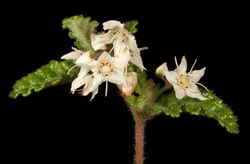Biology:Commersonia corniculata
| Commersonia corniculata | |
|---|---|

| |
| Scientific classification | |
| Kingdom: | Plantae |
| Clade: | Tracheophytes |
| Clade: | Angiosperms |
| Clade: | Eudicots |
| Clade: | Rosids |
| Order: | Malvales |
| Family: | Malvaceae |
| Genus: | Commersonia |
| Species: | C. corniculata
|
| Binomial name | |
| Commersonia corniculata | |
| Synonyms[1] | |
|
List
| |
Commersonia corniculata is a species of flowering plant in the family Malvaceae and is endemic to the southwest of Western Australia. It is an erect to prostrate shrub with 3-lobed, egg-shaped leaves, and white to cream-coloured flowers.
Description
Commersonia corniculata is an erect to prostrate shrub that typically grows to 0.3–2 m (1 ft 0 in–6 ft 7 in) high and 0.4–2 m (1 ft 4 in–6 ft 7 in) wide and its new growth densely covered with white, star-shaped hairs. The leaves are egg-shaped, 8–20 mm (0.31–0.79 in) long and 4–16 mm (0.16–0.63 in) wide on a petiole 1–5 mm (0.039–0.197 in) long with stipules 1–6 mm (0.039–0.236 in) long at the base. The edges of the leaves have 3 lobes and sometimes a heart-shaped base and are rolled under, the lower surface densely covered with star-shaped hairs. The flowers are arranged in clusters of 5 to 15 up to 30 mm (1.2 in) long on a peduncle 4–14 mm (0.16–0.55 in) long, each flower 5–12 mm (0.20–0.47 in) in diameter on a pedicel 1–6 mm (0.039–0.236 in) long. The flowers have five white to cream-coloured, petal-like sepals, five white petals with a linear ligule about the same length as the sepals, and a single white staminode between each pair of stamens. Flowering occurs from August to December and the fruit is a spherical capsule 12–15 mm (0.47–0.59 in) in diameter.[2]
Taxonomy
Commersonia corniculata was first formally described as Lasiopetalum corniculatum in 1822 by the English botanist James Edward Smith, from material gathered at King George Sound by Archibald Menzies.[3][4] In 2018, Kelly Anne Shepherd and Carolyn Wilkins examined the material and determined that it matched the later described species, Commersonia cygnorum (described by Ernst Gottlieb von Steudel in 1845).[5] Since Lasiopetalum corniculatum is the first legitimate description of the plant, the name needed to be changed to Commersonia corniculata.[6]
The specific epithet (corniculata) means "corniculate", referring to the tips of the petals.[7]
Distribution and habitat
This species grows in woodland, heath and between granite boulders in near coastal areas south of Perth, from Busselton to Walpole-Nornalup National Park and near Esperance in the Avon Wheatbelt, Esperance Plains, Jarrah Forest, Swan Coastal Plain and Warren bioregions of south-western Western Australia.[2][8]
Conservation status
Commersonia corniculata is listed as "not threatened" by the Western Australian Government Department of Biodiversity, Conservation and Attractions.[8]
References
- ↑ Jump up to: 1.0 1.1 "Commersonia corniculata". Australian Plant Census. https://biodiversity.org.au/nsl/services/apc-format/display/50593568.
- ↑ Jump up to: 2.0 2.1 Blake, Trevor L. (2021). Lantern bushes of Australia ; Thomasias & allied genera : a field and horticultural guide. Victoria: Australian Plants Society, Keilor Plains Group. pp. 172–173. ISBN 9780646839301.
- ↑ "Commersonia corniculata". Australian Plant Name Index (APNI), IBIS database. Centre for Plant Biodiversity Research, Australian Government. https://biodiversity.org.au/nsl/services/rest/name/apni/50593568.
- ↑ Smith, J.E (1822). Rees, A.. ed. "Lasiopetalum". The Cyclopaedia 20. https://www.biodiversitylibrary.org/page/38748478.
- ↑ Steudel, E.G. von (1845). Lehmann, J.G.C.. ed. "Buttneriaceae". Plantae Preissianae 1 (2): 237. https://www.biodiversitylibrary.org/page/498410.
- ↑ Shepherd, Kelly Anne; Wilkins, Carolyn F. (2018). "Commersonia corniculata (Malvaceae), a new name for C. cygnorum.". Nuytsia 29: 67–68. https://florabase.dpaw.wa.gov.au/science/nuytsia/889.pdf. Retrieved 17 March 2023.
- ↑ Sharr, Francis Aubi; George, Alex (2019). Western Australian Plant Names and Their Meanings (3rd ed.). Kardinya, WA: Four Gables Press. p. 170. ISBN 9780958034180.
- ↑ Jump up to: 8.0 8.1 "Commersonia corniculata". FloraBase. Western Australian Government Department of Parks and Wildlife. https://florabase.dpaw.wa.gov.au/browse/profile/48634.
External links
Wikidata ☰ Q65934782 entry
 |

